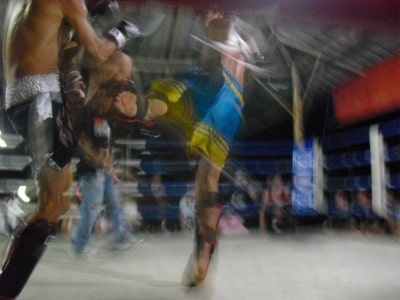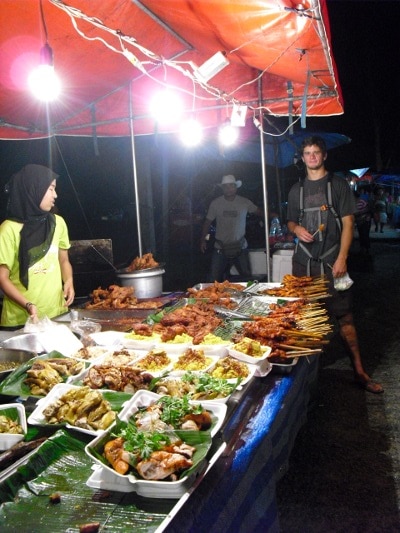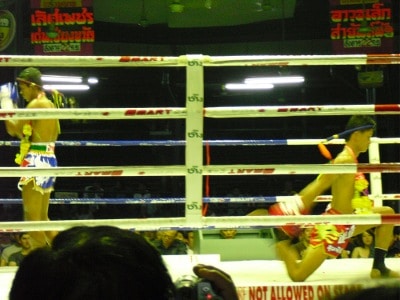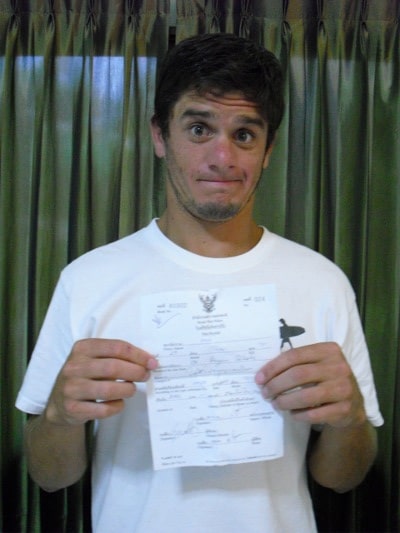
Last week we talked about the history of Muay Thai, and I described my experience watching a fight at Lumpinee Stadium in Bangkok. Muay Thai makes for an engrossing spectator sport, but if you’re going to go all the way to Thailand, you might consider not just watching a fight, but actually learning the art first hand.
With this second installment on the sport of Muay Thai, we’ll provide a general outline of things to consider and what to expect while training in Thailand. Keep in mind that there are always exceptions to the rules; while I will try to be as objective as possible, opinions will vary and ultimately, your choices are your own. After discussing the topic with friends who have also spent some time at Muay Thai camps, the following reflects what we agree on…
Choosing/Finding a Camp
When determining the Muay Thai camp you want to train at, first consider what type of experience you would like to have and what your current level of experience is. To be somewhat simplistic, there are two different types of camps: those geared towards foreigners (farang), and the Thai camps that rarely see a foreign face.
The most accessible, and in my opinion appropriate, type of camp for a foreigner to train at will be those geared towards them. This should not be discouraging; the benefits of training at these camps are many. First off, the majority of them (such as Tiger Muay Thai, Kombat Group Pattaya, Fairtex Bangkok, and Rawai Muay Thai) have excellent facilities, with 10 – 30 heavy bags, multiple rings, and Ratchadamnoen and Lumpinee Stadium champions as trainers. Most will also have a circuit of Thai fighters who live at the camp permanently as is the Thai tradition.
For beginners, these camps are ideal in that the trainers have picked up sufficient English-language skills, making their instructions far clearer than if you were required to play a game of charades for every nuance of communication. For experts and prospective fighters, these camps will also suffice in that the training regimen is grueling, of high-quality, and sufficient to prepare you for fights that they have the connections to arrange. Plus, you will be surrounded by like-minded individuals focused on a common goal. Another aspect of camps such as these is that they are usually located in extremely desirable locations that visitors will want to go to, whether they are training or not. So if you prefer simply to mix in some fitness with your vacation, consider the gyms that are in close proximity to a variety of other activities and attractions.
Thai camps, on the other hand, are commonly in rural, rarely-visited parts of the country or in the heart of the cities of Bangkok and Chaing Mai. They are far more selective when it comes to taking on a foreign trainee, but if you are accepted, training at a Thai camp will give you the ultimate Thai experience. English will be useless; in addition to sculpting your body into a weapon you will be forced to develop your Thai language skills and seek ways to bridge the inherent cultural and linguistic gaps to form friendships. You will be surrounded by Thai fighters who are constantly competing and trainers who are basically surrogate fathers to the wider Muay Thai family.
Getting accepted into a camp of this nature is very rare, often requiring that you be introduced to the camp manager by a Thai friend or a fighter who is willing to vouch for you. You must demonstrate that you have both the endurance and work ethic to commit yourself entirely to the lifestyle of a Thai fighter, conforming to the training regimen and social expectations. In camps like these, according to Stickman Bangkok, perhaps the most important aspect of being accepted is an eagerness and ability to learn the Thai language.
Smaller gyms that also accept foreigners on a regular basis may be the ideal situation. The behemoths of foreigner-focused Muay Thai camps are often critiqued for simply being too big for their own good. Forging lasting friendships with trainers is more difficult due to the simple fact that you are just another face in an endless rotation of tourists who are in and out of the camps before anyone has learned their name.
There are several camps that still have deep Thai roots; they operate more or less the same as they would without the surge of interest in the sport, yet also welcome foreigners. Camps like True Bee in Pai, Eminent Air in Bangkok, Muay Thai Chinnarach in Koh Phangan, and Chay Yai Gym in Chaing Mai are all camps that I have heard great things about and bridge the gap between the Thai/Foreigner camps to some degree.
A friend of mine who has spent a lot of time training in Thailand suggests you look at two things when considering a gym: price and attention. Find a place that can guarantee you no less than three or four rounds one-on-one with a trainer every day, and spending more than 1,000 baht a day (for everything-accommodations/training) is unnecessary unless you are staying in a deluxe cabana or something.
The Training
Training Muay Thai in Thailand was one of the most grueling, exhausting, and painful experiences I’ve ever had. It was also one of the most memorable and enjoyable. Having the opportunity to dedicate myself entirely to a sport was a truly unique and rewarding experience.
A day of training will consist of a morning or afternoon run, two sessions that last between two and three hours each, and fighters will commonly train five to six days a week. Obviously, you will need to set your own limits and work up as your conditioning improves. The training programs of each camp will vary to some degree, but outlined below is what I experienced as a common day.
- 15-30 minute run or skipping rope (In Thailand they use heavy plastic ropes that are as much an upper body work out as they are cardio)
- Stretching and wrapping hands
- 30 minutes of technique (combos, clinch, footwork, etc…)
- Five 4-minute rounds of heavy bag work
- Five 4-minute rounds of one-on-one pad work with a trainer
- Three-Five 4-minute rounds of sparring/clinching (alternating days)
Cool down would commonly consist of 100 or more knees, round kicks, and elbows to the heavy bag, 100-200 sit ups, and too many push-ups. In between each round of heavy bag, pads, and sparring, the trainers would generally have us do 10-20 push-ups. Stretch at the end, and then go rehydrate, eat food and relax until the afternoon session begins. The afternoon session would be virtually the same as the morning with minor deviations.
In the beginning, go at your own pace until your stamina builds sufficiently. Training with such intensity and frequency (especially while in a tropical climate), will break down your immune system, and spending your time in Thailand sick in bed is a waste. Let your body work up to the schedule.
*Tip: One way to mentally prepare and toughen up for the training is by staring things to death, like I did here with this Cobra:

Accommodation Options
Accommodations in Thailand can be as economical or expensive as you want, depending on what you can afford, or alternatively, are willing to put up with. There are beach cabanas, guesthouses, high-end hotels, budget rooms and bungalows. Some will have fans and some will have air conditioning, a fridge, WiFi, private bathrooms, TVs, etc…
Some gyms offer accommodations at the camp. If your sole purpose is to train hard and you are not traveling with a significant other, I would recommend this. In the morning you will be woken up to music ringing out from all over camp and the sharp crack of shins on Thai pads.
Everywhere you look people will be pushing themselves to their limits; you begin to feel Muay Thai in your very being. Staying at camp eliminates excuses, whereas if you are staying halfway between the camp and the beach, and your body still aches from training the day before, that beach suddenly becomes that much more appealing. Waking up at camp will keep you honest.
*Tip 2: Sometimes it’s not a bad idea to bail on training and watch sunsets like this instead:

The potential drawback is that the atmosphere of a farang camp can become a testosterone-filled boy’s town, where frequent trips to the red light districts are a popular pastime among many foreign fighters and depending on your lifestyle, this may become obnoxious.
If you are on a very tight budget, staying in a budget room or bungalow without A/C is a great way to save money and depending on where you are, these rooms can be as cheap as $3 a night. But between training and the oppressive heat that seemed to never dissipate, I always sprung for rooms with A/C.
To give you an example, as of September of 2010, budget rooms at Tiger Muay Thai in Phuket go for 1500 baht/week (approximately $50), while their resort-style bungalows with all the fixings are 8,500 baht/week (approximately $280).
Hydration and Sustenance
The food in Thailand is so tremendously delicious that it is hard not to spend your entire day sampling every curry or Tom Ka Gai (coconut soup) that you can find. Street food is everywhere and extremely affordable. I know that some people are a little wary of eating street food; all I can say is that it was my goal to eat as much of it as possible, and I never got sick. That being said, I do have a couple of tips. If you are going to eat street food, watch it get cooked and consider avoiding the seafood. The few people I met who ended up with a case of Deli Belli generally attributed it to street seafood. Expect to pay between $.50 and $4 for a meal, unless of course you are going for the higher-end restaurants.
Tip #3: Never ever ever pass up the grilled chicken at the night markets. If sauce is an option, lather it on thick. Each stall will have their own sauce with a wide range of spice:

I cannot stress the importance of hydration enough. While you are training you will sweat a personal flood capable of drowning the entire Midwest. The weather is HOT and HUMID, and even after a fresh shower and a cold beer you will sweat like Victoria Falls. It is never-ending, and resupplying your body with fluid and electrolytes is crucial in maintaining your health. So here’s the key: At nearly every pharmacy in Thailand, you can buy electrolyte packets called De-Champ. It is basically the Thai version of Gatorade. They come in two flavors: orange and purple. The taste: not bad, really. Drink one gallon of water or more a day while you are training and mix in two packets of De-Champ. Don’t chug it all at once unless you want a side-stitch that feels like your guts are being removed with a spoon. Drink frequently and take small sips.
Getting a Fight
So either you have been training hard back at home and have come prepared, or you have been in Thailand for quite awhile, and it is time to get a fight. If you want a fight, your camp can get one for you. When you are ready. Make sure that your trainers are aware that a fight in a regional stadium is your goal, and they will prepare you for it.
You may hear things like, “foreigners only fight taxi-cab drivers,†or that you’ll fight “the guy that runs the hotel down the street who only does it for some extra money,†or that “Thais are paid to throw the fights.â€
Maybe.
The politics of any fight game are vulnerable to Don King-like corruption, with people at every corner looking to make some money or build their fighter’s confidence or ensure a win to keep the clientele coming in. The fights that I witnessed were never easily won. Sometimes a farang would be the victor with his hands held high at the end of his fight…other times they’d leave the ring unconscious. It seems to me that the fights are generally decent match-ups based on skill level and weight.

Before fighting you will learn your trainer’s Ram Muay, and as a show of respect, you will perform both the Wai Kru and Ram Muay once you enter the ring. The energy of the crowd will be buzzing in your ears and in your gut; the release of adrenaline will race like snakes through your veins. The music will be singing out in shrills and twangs, increasing in tempo and volume. The old men will be shouting their bets and then the bell will ring, and you will be contained within a battlefield of ropes and canvas, with a fighter who has been training as hard as or harder than you have been. Whatever the outcome, you will have done something.
Getting Around
Getting around in Thailand is like playing a live game of Chaos-Tetris. Maneuver with haste and confidence, fit in where you can, and go with the flow of traffic – even if the traffic is entirely ignoring the red light in front of you. Scooters are the vehicle of choice, and they choke the streets with exhaust and abundance. Renting one runs about $3-$6 a day or less if you can get a weekly/monthly rate. The cheaper ones are manual. Remember, you’ll be on the left side of the street.
*Tip 4: Avoid tickets at all costs, even if it means running from an officer wielding a firearm. See, I failed in my escape and evade attempt and wound up with a 300 baht ticket. A sum that could easily have purchased several meals, one night’s accommodation, and maybe even a dollop of coconut ice cream:

Alternatively, you can hail tuk tuks or taxis. Tuk tuks can be a hassle when it comes to payment, so if you are in the larger cities, stick to the metered taxis to avoid any conflicts or disagreements. Just make sure the meter is actually turned on, or you agree on a price before you leave.
One Last Note:
The Thai people are incredibly friendly and delightfully playful. Despite current political problems going on in the country, Thailand is a very safe place to travel. I often found that the locals were willing to bend over backwards to help me find my way when lost or to offer suggestions about a place, food, or attractions. If you do end up traveling there, take some time to chat with the locals and share stories to appreciate each other’s culture.
Resources for Further Information and Debate
The forums at Sherdog.com are great for talking about specific camps and learning about other fighters’ experiences in Thailand. There are constant debates about which gyms are the best and for what reasons, as well as any other issues relating to Muay Thai.
Camps:
Muay Thai Chinnarach in Koh Phangan (Island in the Gulf)
Suwit Muay Thai Camp in Puket (Southern Thailand)
Tags: Self-Defense & Fighting

